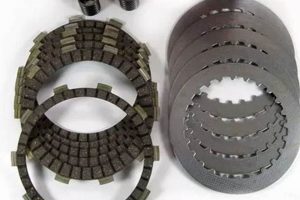The process of aligning vehicle wheels utilizing self-directed methods and tools represents an accessible approach to automotive maintenance. This typically involves employing readily available equipment and techniques to assess and adjust wheel angles, aiming for optimal handling and tire wear. An example includes using string lines and levels to approximate proper toe and camber settings.
Proper wheel alignment is crucial for vehicle safety, fuel efficiency, and tire longevity. Historical limitations in accessibility to professional alignment services motivated individuals to explore alternative, do-it-yourself solutions. This approach can lead to cost savings and a greater understanding of vehicle mechanics, although precision may vary compared to professional services.
The following sections will delve into specific methods, tools, and considerations involved in performing the procedure, addressing potential challenges and highlighting safety precautions. Detailed analysis of the measurement and adjustment processes will be presented, offering insights into achieving acceptable results through independent effort.
Essential Considerations for DIY Wheel Tracking
The following provides critical insights to ensure accurate and safe implementation of self-directed wheel alignment procedures. Adherence to these guidelines will contribute to improved vehicle handling and extended tire life.
Tip 1: Ensure a Level Workspace: Accurate measurements depend on a perfectly flat and level surface. A concrete floor is recommended; verify its levelness with a spirit level. Inconsistent surfaces introduce errors that propagate throughout the alignment process.
Tip 2: Employ Precise Measurement Tools: Invest in accurate measuring instruments such as digital levels, angle finders, and measuring tapes. Avoid relying solely on visual estimations, as these are prone to subjective interpretation and inaccuracies.
Tip 3: Prioritize Toe Adjustment: Toe is the most critical angle to address and often the easiest to adjust. Correcting toe minimizes tire wear and improves straight-line stability. Consult vehicle specifications for optimal toe settings.
Tip 4: Verify Steering Wheel Centering: Before making any adjustments, ensure the steering wheel is centered. Misalignment here leads to directional instability and necessitates recalibration after adjustments.
Tip 5: Conduct Multiple Measurements: Take multiple measurements at each step to ensure consistency and identify potential errors. Averaging readings mitigates the impact of minor variations.
Tip 6: Torque Fasteners Correctly: When adjusting tie rod ends or other components, adhere strictly to specified torque values. Over-tightening damages threads, while under-tightening leads to looseness and potential component failure.
Tip 7: Document All Adjustments: Maintain a detailed record of each adjustment made, including measurements before and after. This documentation facilitates troubleshooting and future refinements.
Effective implementation of these measures promotes greater accuracy and safety during the process of aligning vehicle wheels using self-directed methods. Results may vary, and professional services guarantee certain level of precision.
With careful planning and execution, these strategies help to navigate the intricacies of self-directed wheel alignment and achieve results. The conclusion of this article will reinforce the importance of safety and continuous learning in the pursuit of competent automotive maintenance.
1. Accuracy
In the context of self-directed vehicle alignment, accuracy directly influences handling characteristics, tire wear, and overall vehicle safety. The degree of precision attained during the alignment process determines how closely the wheel angles conform to the vehicle manufacturer’s specifications. Imprecise measurements or adjustments propagate into alignment errors, leading to undesirable consequences. For example, inaccurate toe settings result in accelerated tire wear, while camber errors impact cornering performance and stability. A lack of accuracy negates the benefits sought through the endeavor.
The practical significance of accuracy is evident in the vehicle’s responsiveness and road manners. Properly aligned wheels contribute to straight-line tracking, reduced steering effort, and improved fuel efficiency. Conversely, deviations from specified alignment parameters lead to instability at higher speeds, increased rolling resistance, and potentially dangerous handling characteristics. Therefore, the selection of appropriate measurement tools, the careful execution of procedures, and a comprehensive understanding of alignment principles are vital for achieving acceptable accuracy levels. It is important to reiterate results may vary, and professional services guarantee certain level of precision.
Achieving accuracy in self-directed alignment presents challenges, including the inherent limitations of non-professional equipment and the potential for human error. Despite these challenges, meticulous attention to detail, adherence to established procedures, and a critical assessment of results contribute to improved outcomes. While professional alignment services offer the highest degree of precision, careful and informed approaches to the self-directed wheel alignment can offer functional benefits and a deeper understanding of vehicle dynamics.
2. Component Condition
The condition of various suspension and steering components exerts a direct influence on the accuracy and longevity of any self-directed wheel alignment effort. Worn or damaged components introduce play and instability, undermining even the most precise alignment adjustments. For example, worn ball joints, tie rod ends, or wheel bearings allow for unwanted movement, causing the wheel angles to shift unpredictably during driving. This necessitates replacing these components before attempting a DIY alignment, a process which itself can be part of DIY car ownership.
Ignoring component condition leads to a cycle of repeated alignment adjustments and premature tire wear. An improperly functioning suspension system will continuously revert to a misaligned state, negating the initial work. The practical significance of this is evident in scenarios where individuals meticulously align their wheels only to find that the alignment deteriorates rapidly due to underlying mechanical issues. Diagnosing and addressing component problems is paramount to achieving stable and lasting alignment results. Identifying loose parts might mean applying temporary fixes if the user cannot procure suitable replacements in the short term.
Prioritizing component inspection and replacement before initiating the alignment process is crucial for achieving favorable outcomes. While self-directed wheel alignment offers an avenue for cost savings and enhanced understanding of vehicle dynamics, i
t requires a comprehensive approach that accounts for the health of all interconnected components. Failing to address worn parts translates to a compromised alignment, emphasizing the need for a holistic view of vehicle maintenance. A user must factor these component costs, especially when considering the overall investment versus having a professional perform the alignment.
3. Measurement Consistency
In self-directed wheel alignment, measurement consistency represents a cornerstone of accuracy and reliability. The degree to which successive measurements of wheel angles yield similar results directly affects the overall quality of the alignment. Variations in measurements introduce uncertainty, potentially leading to incorrect adjustments and compromised vehicle handling.
- Tool Calibration and Usage
Consistent measurements necessitate properly calibrated tools and standardized usage techniques. Deviations in tool calibration or inconsistent application introduce systematic errors, skewing results. For instance, a digital level requires periodic calibration to ensure accurate angle readings. Furthermore, the user must apply the tool consistently across all measurements, maintaining the same angle of application and ensuring proper contact with the measurement surface.
- Environmental Factors
External factors such as ambient temperature, surface irregularities, and vibrations can influence measurement readings. Temperature variations can cause expansion or contraction of components, altering wheel angles. Uneven surfaces introduce inconsistencies in leveling and plumbness, affecting angle measurements. Similarly, vibrations from nearby machinery or passing traffic disrupt the measurement process. Mitigating these factors through controlled environments and stable setups is essential for ensuring measurement consistency.
- Procedural Repetition and Averaging
Repeating measurements multiple times and averaging the results can minimize the impact of random errors. Each measurement inherently involves a degree of uncertainty. By taking multiple readings and calculating the average, random errors tend to cancel out, yielding a more accurate representation of the true value. This approach is particularly beneficial when employing less sophisticated measurement tools or when environmental factors introduce noise into the measurement process.
- Reference Point Stability
Maintaining stable reference points throughout the measurement process is crucial for consistency. The reference points serve as the basis for measuring wheel angles. Any movement or shifting of these reference points introduces errors. In self-directed wheel alignment, the reference points typically involve the vehicle chassis, wheel hubs, or other fixed structures. Ensuring the stability of these points through secure mounting and careful handling prevents the propagation of errors into subsequent measurements.
The multifaceted nature of measurement consistency underscores its importance in achieving reliable results. By addressing factors related to tool calibration, environmental conditions, procedural rigor, and reference point stability, the self-directed practitioner increases the likelihood of accurate alignment adjustments. Consistent measurements, in turn, contribute to improved vehicle handling, reduced tire wear, and enhanced overall safety. Without this emphasis on consistent measurement the validity of any attempt at independent wheel alignment is rendered questionable at best, and potentially dangerous.
4. Proper Tools
The successful execution of self-directed vehicle wheel alignment is inextricably linked to the utilization of appropriate tools. Access to, and competent application of, specific instruments determines the achievable accuracy and overall safety of the alignment process. Without the requisite tools, even the most knowledgeable individual faces significant limitations.
- Digital Levels and Angle Finders
These tools provide precise angle measurements crucial for assessing camber and caster. Traditional bubble levels lack the resolution needed for accurate alignment. Digital levels, with their ability to display angles to a tenth of a degree, enable finer adjustments. Angle finders, particularly those equipped with magnetic bases, facilitate measurement on uneven surfaces. Their use allows for quantifying the precise deviations from factory specifications, a key step in the process.
- Measuring Tapes and String Lines
Measuring tapes and string lines are employed to determine toe, the angle of the wheels relative to each other. A precise tape measure allows for accurate distance measurements between specific points on the wheels, revealing toe-in or toe-out conditions. String lines, stretched taut alongside the vehicle, create a visual reference for assessing wheel alignment. The combination of these tools provides a cost-effective method for approximating toe settings, although with limited precision compared to specialized equipment.
- Turntables or Slip Plates
These devices allow the wheels to rotate freely during adjustments, minimizing friction and ensuring accurate measurements. Turntables, placed under the front wheels, enable steering adjustments without binding. Slip plates, positioned under all four wheels, allow for slight movement in all directions, simulating the dynamic conditions of driving. The use of these tools prevents artificially induced forces from affecting alignment readings.
- Wheel Alignment Gauges
Specialized wheel alignment gauges, either mechanical or laser-based, offer the most accurate means of measuring wheel angles. Mechanical gauges utilize a system of levels and scales to directly indicate camber, caster, and toe. Laser-based gauges project beams of light onto targets attached to the wheels, providing precise measurements that can be read electronically. These gauges, while often expensive, deliver the highest degree of accuracy and repeatability, mimicking professional alignment equipment.
The selection of proper tools is a critical determinant of success in self-directed wheel alignment. While basic tools may suffice for rough adjustments, achieving optimal results necessitates the use of instruments designed specifically for alignment purposes. Investment in appropriate tools, coupled with careful application and a thorough understanding of alignment principles, significantly enhances the likelihood of achieving accurate and lasting alignment results. The absence of such tools greatly increases the risk of incorrect adjustments and potential vehicle damage.
5. Sequential Adjustment
In the context of self-directed vehicle wheel alignment, sequential adjustment refers to the methodical process of altering wheel angles in a prescribed order to achieve optimal handling and minimize tire wear. The alignment parameterstoe, camber, and casterinteract dynamically, meaning an adjustment to one affects the others. Therefore, adhering to a logical sequence is essential to prevent compounding errors and to streamlin
e the overall procedure.
Typically, toe is addressed first, as it directly impacts tire wear and straight-line stability. Subsequent adjustments to camber and caster influence handling characteristics and directional control. An incorrect sequence, such as adjusting camber before toe, can necessitate repeated adjustments and prolong the process. For instance, imagine an individual attempting to correct camber without first establishing the proper toe setting; the resulting adjustments may prove futile as the toe influences camber readings. Similarly, neglecting caster can result in steering instability, requiring further corrections even after toe and camber are within specified ranges. A sequential methodology prevents such complications.
The practical significance of sequential adjustment is most apparent in terms of efficiency and accuracy. By adhering to a logical sequence, the effort required to achieve proper alignment is minimized, and the likelihood of achieving satisfactory results is maximized. While professional alignment equipment often facilitates simultaneous adjustments, DIY approaches typically require a step-by-step methodology. Embracing sequential adjustment enables achieving functional results, although with the acknowledgement of potential variations compared to professional services.
6. Torque Specifications
Adhering to specified torque values is a critical component of self-directed vehicle wheel alignment, ensuring component integrity and long-term alignment stability. Deviations from recommended torque specifications can lead to premature failure of suspension and steering components, compromising vehicle safety and negating the benefits of the alignment procedure. Neglecting proper torque represents a potential for catastrophic failures of critical systems.
- Fastener Integrity
Applying the correct torque to fasteners ensures that they are neither under-tightened nor over-tightened. Under-tightening can lead to loosening over time, resulting in component movement and alignment shift. Conversely, over-tightening can strip threads or damage fastener materials, weakening the connection and increasing the risk of failure. For example, improperly torqued tie rod end fasteners can cause steering instability and accelerated wear, while over-tightening can lead to component damage. The correct torque value provides the optimal balance between clamping force and material stress.
- Suspension Component Longevity
Proper torque values are engineered to distribute stress evenly across suspension components, maximizing their lifespan. Over-tightening stresses the fastener and the surrounding material, predisposing them to fatigue and cracking. Under-tightening allows for movement and vibration, which can also accelerate wear. Correct torque application preserves the structural integrity of suspension components, extending their service life. For instance, control arm bolts that are improperly torqued can lead to premature bushing failure and increased suspension noise.
- Alignment Stability
Accurate torque specifications contribute to the long-term stability of wheel alignment settings. If fasteners are not properly torqued, the suspension components can shift slightly over time, causing the alignment to drift. This leads to premature tire wear, diminished handling performance, and a need for frequent re-alignment. Maintaining proper torque values ensures that the suspension remains securely assembled, preserving the intended wheel angles. For example, if the bolts securing the strut to the steering knuckle are not properly torqued, the camber angle can shift over time, affecting tire wear and handling.
In essence, meticulous adherence to torque specifications is not merely a procedural detail but a fundamental element of safe and effective self-directed wheel alignment. By ensuring that fasteners are properly tightened, individuals enhance the integrity of suspension components, prolong their lifespan, and preserve the stability of alignment settings. Deviations from specified torque values compromise vehicle safety and negate any effort applied to achieve acceptable alignment.
7. Safety Precautions
Self-directed vehicle wheel alignment presents inherent risks, necessitating strict adherence to safety precautions. The potential for injury from falling objects, improperly secured vehicles, or misuse of tools is ever-present. Neglecting safety protocols can lead to severe consequences, ranging from minor abrasions to life-threatening incidents. The absence of professional supervision amplifies the importance of individual responsibility and diligent risk mitigation. A stable workspace, proper vehicle support, and correct tool handling are fundamental aspects of safety during this process. For example, failure to properly secure a vehicle on jack stands before working underneath can result in catastrophic collapse, causing severe or fatal injuries.
The integration of safety practices throughout the entire alignment process is paramount. This includes, but is not limited to, the use of personal protective equipment (PPE) such as safety glasses and gloves, understanding the correct operation of alignment tools, and following manufacturer’s instructions for all procedures. Additionally, a thorough inspection of vehicle components before commencing work can identify potential hazards such as corroded brake lines or weakened suspension members. Addressing such issues proactively minimizes the risk of unexpected failures during the alignment procedure. Another example is disconnecting the negative terminal from the battery to prevent accidental electrical shorts while working near sensors or electrical components related to steering or suspension systems.
Ultimately, prioritizing safety during independent wheel alignment is not merely a recommendation but a crucial element of responsible vehicle maintenance. Understanding the potential hazards, implementing appropriate preventative measures, and maintaining a vigilant awareness of surroundings significantly reduces the risk of accidents and injuries. The successful completion of wheel alignment adjustments is secondary to ensuring personal safety and preventing damage to the vehicle. Therefore, meticulous attention to safety precautions must be considered an intrinsic component of any self-directed wheel alignment endeavor.
Frequently Asked Questions about DIY Wheel Tracking
The following addresses common inquiries concerning independent vehicle wheel alignment, offering clarification and insights into its practical application.
Question 1: Is self-directed wheel tracking a suitable substitute for professional alignment services?
Self-directed alignment can offer functional benefits and cost savings; however, it typically does not achieve the same level of precision as professional alignment services. Professional equipment and trained technicians provide a higher degree of accuracy and comprehensive diagnostics.
Question 2: What are the minimum required tools for attempting DIY wheel tracking?
The minimum essential tools include a digital level or angle finder, a precise measuring tape or string line, and basic hand tools for loosening and tightening fasteners. While these tools allow for basic adjustments, specialized alignment gauges enhance accuracy.
Que
stion 3: How crucial is a perfectly level surface for DIY wheel tracking?
A level surface is paramount for accurate measurements. Inconsistencies in the surface introduce errors that propagate throughout the alignment process. A concrete floor is recommended, and its levelness should be verified with a spirit level.
Question 4: What are the potential risks associated with improperly performed DIY wheel tracking?
Improperly performed alignment can lead to premature tire wear, compromised handling stability, and potential damage to suspension components. Incorrect adjustments can create unsafe driving conditions and necessitate costly repairs.
Question 5: How often should wheel alignment be checked and adjusted, even with professional service or DIY wheel tracking attempt?
Wheel alignment should be checked at least annually or whenever there are indications of misalignment, such as uneven tire wear, pulling to one side, or steering wheel vibration. Road hazards and suspension impacts necessitate more frequent checks.
Question 6: Can DIY wheel tracking correct all alignment issues?
DIY alignment primarily focuses on adjusting toe, camber, and sometimes caster. However, underlying suspension problems, such as worn components or damaged frames, require professional attention and cannot be rectified through alignment adjustments alone.
DIY wheel tracking can achieve functional results, but acknowledge limitations compared to professional services. Safety must be prioritized at all times.
Considerations for ensuring accuracy in this process have been covered. The next part will introduce a checklist.
DIY Wheel Tracking
The preceding exploration illuminated the complexities and considerations inherent in self-directed vehicle wheel alignment. Emphasizing the crucial role of accuracy, component condition, measurement consistency, proper tools, sequential adjustment, torque specifications, and stringent safety precautions, the aim has been to provide a comprehensive understanding of this undertaking. DIY wheel tracking offers a potentially cost-effective alternative to professional services, however, it demands a meticulous approach and an honest assessment of one’s capabilities. The information presented is intended to educate and inform, not to encourage reckless or ill-prepared attempts at vehicle maintenance.
Ultimately, the decision to engage in DIY wheel tracking rests with the individual, weighed against their proficiency, access to appropriate equipment, and awareness of potential risks. If proper, professional wheel tracking can not be achieved by the user with their attempt, a user must consult with a professional.







